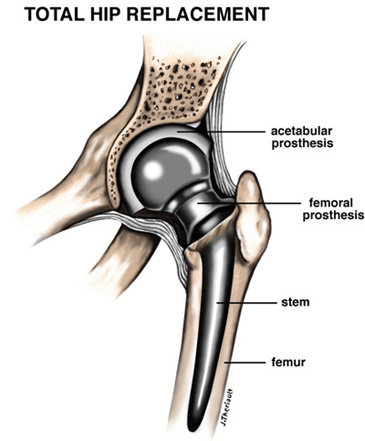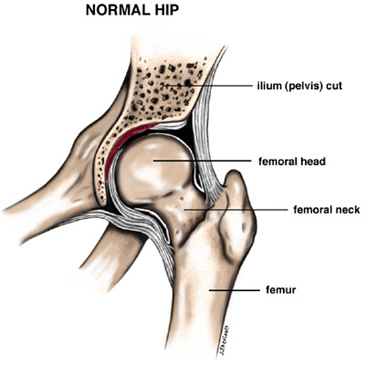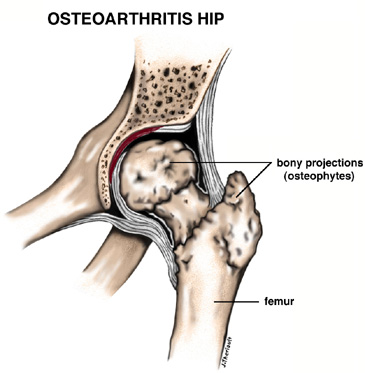Total Hip Replacement Surgery
Replacing Your Problem Hip

A painful, stiff hip can keep you from doing the simple things in life, like walking without pain. Today, physicians can replace your problem hip, thanks to improved surgical techniques and materials. Total hip replacement is a safe, reliable procedure that can relieve your pain and stiffness and return you to most of the activities you enjoy. Nearly 600,000 primary hip and knee arthroplasties are performed in the United States each year. Total hip arthroplasty is the replacement of a worn out hip with an implant that is designed to function like the patient’s own joint prior to the onset of the disease process.
When Walking Hurts
As hip pain and stiffness increase, you may find more and more things you cannot do. Simply walking or getting up from a bench can hurt. Hip pain and stiffness often results from osteoarthritis (the breakdown of cartilage in your joints), which makes your hip bones grate painfully together. Osteoarthritis (OA) is the most common cause of musculoskeletal pain and disability. Generalized susceptibility is reflected by age associations, positive family history, diabetes, and hypertension. Patients who have had childhood hip disorders such as congenital dislocation, Perthes disease, or slipped capital femoral epiphysis are at an increased risk of developing OA at an earlier age. This is because these childhood afflictions alter the mechanics of the hip joint, leading to increased pressure and early loss of articular cartilage. Other causes of OA include trauma or infection, both of which can lead to loss of joint cartilage or altered joint mechanics.
All hip pain is not OA. There are many disorders of muscle and soft tissue around the hip that can mimic the pain caused from arthritis. Pain from disorders in the spine, such as spinal stenosis or slipped disk, can also be referred to the hip region. Other hip problems include rheumatoid arthritis, injury, and loss of blood supply to the bones of your hip.
Your Hip Anatomy
Your hip is a simple ball-and-socket joint, where your thigh bone joins with your pelvis. Surrounded by cartilage, muscles, and ligaments, your hip is the largest weight-bearing joint in your body. Smooth cartilage and bone help you walk easily and without pain. In a normal hip, both the femoral head and the acetabulum are covered with a thick layer of articular cartilage. It is this thick layer of cartilage that protects the underlying bone and acts as a gliding surface (with less friction than water on ice) during pain free joint motion.
|
|
|
|
In a healthy hip, smooth cartilage covers the ends of your hip bones, allowing the ball to glide easily in the socket. Smooth weight-bearing surfaces allow for painless movement. |
In a problem hip, the cartilage “cushion” wears away, and the bones rub together, becoming rough and pitted. The ball grinds in the socket when you walk, causing pain and stiffness. |
Your New Hip
Technical advances have given us new materials to utilize when replacing your problem hip with a prosthesis (artificial hip joint). Like your own hip, your prosthesis is made up of a ball and socket that fit together to form a joint. Our team chooses the best prosthetic design for you after carefully diagnosing your particular hip problem. 90% of hip replacements will still be in place at 15 to 20 years after surgery. Activities such as walking, swimming, golf, and bicycle riding are all encouraged. Activities involving impact loading of the hip joint, such as basketball and jogging, are discouraged because they can accelerate the wear of the plastic liner.
Your Orthopedic Evaluation
Our team specializes in bone and joint surgery. Surgery is recommended only after diagnosis of your hip problem, including your degree of pain and lack of mobility.
Your history includes questions about your hip pain, medications you may be taking, prior injuries, and other bone and joint problems you may have, such as rheumatoid arthritis.
Your physical examination includes assessing the range of motion in your hip and other mechanical medical factors.
X-rays provide our team with a picture of your hip bones and joints. X-rays also help in the precise fitting of your new hip.
Joint aspiration (removing a small amount of fluid from the affected hip joint) to check for infection may also be performed.
Before Surgery
In addition to following our team’s instructions, there are several things you can do to prepare yourself for surgery. You may be asked to lose extra weight, since extra weight puts extra stress on your new hip. You will be asked to AVOID ASPIRIN, BLOOD THINNERS, OR ANTI-ARTHRITIS MEDICATIONS FOR TWO WEEKS PRIOR TO SURGERY to help decrease the chance of post-operative lung complications.
Understanding the Risks
Total joint replacement is only undertaken after all non-operative measures are exhausted. Because hip replacement is an elective surgical procedure with inherent medical risk, optimal medical status is assured prior to surgery. Risks include infection, blood clots, pneumonia, stroke, heart attack, loosening of the hip, dislocation, fracture of bone or implant, injury to nerve or blood vessels, leg length discrepancy, persistent pain, and other post-operative complications. Infection in your hip joint is the most devastating complication of total joint replacement. Infection occurs in 0.5% of all patients. Patient awareness of this complication may prevent the need for removal of the implants. It is important to seek medical advice from your orthopedic surgeon as soon as possible if your previously painless hip implant becomes painful. Diagnosis of infection in the hip joint can be difficult. Your doctor will discuss this with you before surgery. Make sure you understand the risks and alternatives prior to surgery.
Alternatives
Osteoarthritis is characterized by joint pain and stiffness. The pain tends to be aggravated by activity and is usually worse towards the end of the day. The pain can be felt in the groin, buttock, or lateral thigh. Conservative treatment entails gentle activity to maintain joint motion and muscles strength. Non-steroidal anti-inflammatory medication is also helpful in reducing joint discomfort associated with OA. However, over zealous use of these medicines can be harmful in some situations, and have been associated with side effects such as GI bleeding, and liver dysfunction. Reduction in the stress that the hip joint receives can be quite helpful in reducing pain. This can be accomplished with weight loss, or by use of a cane held in the hand opposite the affected hip. Other alternatives may include alternate surgeries.
Your Surgery
You may be admitted to the hospital one or two days prior to surgery. You cannot eat or drink anything after midnight the evening prior to surgery. The day of surgery, you may also be given an injection to help you relax. You can also expect an IV (intravenous) line for medications and for blood transfusions, which are usually needed. Most patients donate their own blood prior to surgery for blood transfusions.
In the Recovery Room
After surgery, you may wake up feeling a bit groggy. Specially trained nurses will be with you to make you comfortable and give you pain medication for any discomfort. A pillow between your legs may be used to keep your new hip in position. An IV provides antibiotics and fluids if needed, and a small tube drains your incision. Your nurses can help you with coughing and deep breathing exercises, to help prevent lung complications and start you on the road to a safe recovery.
Your Hospital Recovery
The key to your successful hospital recovery is keeping your hip in position as it heals. After a short period of initial healing, you will be started on easy physical therapy exercises to promote healing and get you walking again before you go home. While you are in the hospital, your surgeon and physical therapist will teach you about the care of your new hip.
Initial Healing
After a total hip replacement, you can expect to mobilize quite quickly. To keep your new hip in position, you may have a special bed that keeps your hip from bending beyond 90 degrees. An abduction pillow keeps your legs shoulder-width apart and prevents them from rotating inward. Support stockings may be used to help prevent circulation problems. It is important to remember that extreme positions, especially in the early post-operative period, can cause hip dislocation. Do not be afraid to use pain medicine liberally as post-op discomfort can slow your rehabilitation.
Physical Therapy
Gentle physical therapy exercises help strengthen the muscles around your new hip and regain your hip’s range of motion. As soon as possible, your physical therapist helps you start walking, a few steps at a time, to promote healing. As you progress from a walker to crutches, and then a cane, you may feel somewhat off balance at first. Gait training helps you regain confidence and your normal walking motion before going home. The lengths of both your legs will be measured. Sometimes there will be a mild difference, because you now have a new hip on one side and possibly a worn hip on your other side. Occasionally, a shoe lift is used to correct this.
Going Home
Once your hospital recovery is complete, our team discharges you, and your nurses can help you pack and make arrangements for going home or to a rehabilitation center for a short time. Your sutures and bandages are usually removed before going home, and you may be given pain or other medications to take with you. Before you leave the hospital, you are given any necessary instructions for your safe home recovery. Be sure to ask any questions you may have.
Your Home Recovery
At home, you will still need to limit your hip bending. Otherwise, your new hip can slide out of position. Your family and friends can help you follow our team’s home recovery instructions, which are especially important during the first few months of healing.
Back at Work
Work can be resumed as soon as you have greater than 90% of the strength back in your leg, and can perform activities while in therapy that mimic the range and flexibility required for your occupation.
Limit Hip Bending
With your new hip, your safe maximum hip bend is 90 degrees. Four rules of thumb is remember to keep your hip in position:
-
When sitting, keep your knees below your hips (sitting on a small pillow helps).
-
Avoid crossing your legs while lying down or sitting.
-
Avoid bending over at the waist.
-
Sit with your legs 3-6 inches apart.
Some Helpful Hints
Follow your doctor’s advice on using crutches or a cane to keep weight off your hip as it heals.
To limit bending, you may want to buy a raised toilet seat, a bath bench, long-handled grippers to reach things on the floor, or other self-help devices.
Playing golf with a cart, swimming, upper-body exercises, and other moderate activities are fine; more active sports such as tennis and skiing are not recommended.
Since your balance may be off, use hand rails and wear low shoes for your safety.
Before minor surgery or dental work, remind your doctor that you have a prosthesis; antibiotics are usually needed to prevent infection.
It is recommended that all total joint replacement patients have antibiotic prophylaxis for dental, GI, and GU procedures that can cause transient bacterium, which could possibly seed a normal implant. Instructions regarding the right antibiotic and proper dose will be given to you after your surgery.
Because people live longer now, you may outlive your hip. Your prosthetic hip can be replaced if necessary.
Caring for your Hip
Your hip prosthesis is the result of years of research. But like any other device, your new hip’s lifespan depends on how you care for it. In your follow-up visits after surgery, your doctor will follow your progress and answer any questions you may have about caring for your new hip.
Back in the Swing of Things
Replacing your problem hip with an artificial hip can relieve your pain and stiffness and return you to most of the activities you enjoy. A problem hip can be safely replaced at any age, and, with proper care, can last for many active years. With your new hip, you can look forward to getting back in the swing of things.
REPORT TO EMERGENCY SERVICES IMMEDIATELY IF YOU NOTICE REDNESS OF YOUR WOUND, DRAINAGE, CALF PAIN, SHORTNESS OF BREATH, OR ANY CONCERNS.

